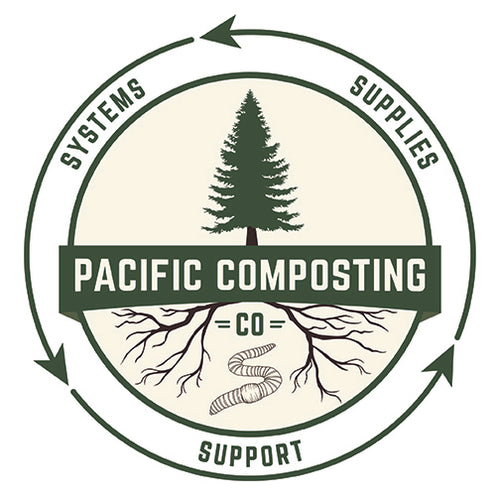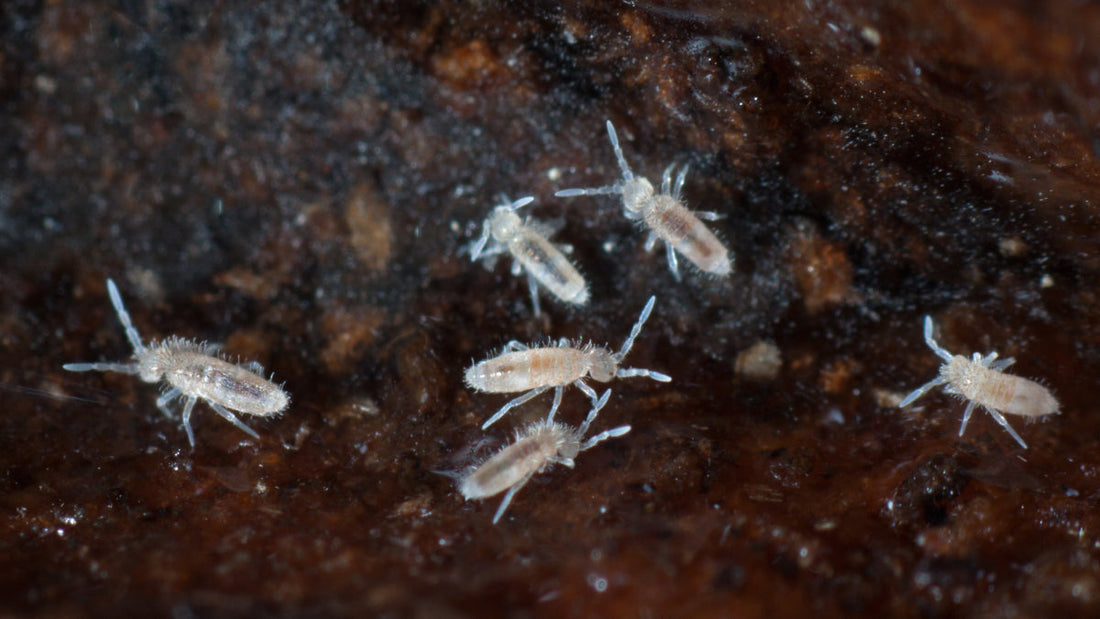If you haven’t already, be sure to check out Part I in our worm bin macro invertebrate series: “An Introduction to Worm Bin (Macro) Invertebrates”.
Many new vermicomposters have been alarmed to open up their worm bin and find an unexpected carpet of small, white critters that has appeared, seemingly overnight!
There are a handful of different white organisms that can commonly show up in a worm bin (be sure to check out our “white critters” FAQ if you are still trying to determine which one(s) you have), but springtails are one of the more common ones you’ll encounter.
In this first official macro invertebrate profile we will look at what springtails are, how to know when you have them, why and when they tend to show up in great abundance, and what you can do to help keep our systems more balanced (SPOILER: this is not to say “springtail-free”)!
What Exactly Are Springtails?
 Once considered a primitive form of insect, springtails have been moved to their own class, Collembola (insects and collembolans are now grouped together in subphylum, Hexpoda).
Once considered a primitive form of insect, springtails have been moved to their own class, Collembola (insects and collembolans are now grouped together in subphylum, Hexpoda).
What Do They Look Like?
- 1-4 mm in length
- Somewhat elongated (not round)
- Have insect-like legs and antennae
- Are quite active.
As the common name suggests, many varieties of springtail have a spring-like abdominal appendage (known as a “furcula” or “furca”) that’s used for jumping. Interestingly, the temperate white springtails that tend to be found in worm bins seem to prefer running (and may, in fact, have lost their ability to jump).
Why Are They In My Bin?
Like many other worm bin organisms, springtails are highly talented opportunists - rapidly taking advantage of favorable conditions and resources - but they can also make their presence known for other reasons.
Two main things to keep a close eye on are:
Over-Feeding
If you are adding more food than the worms can process within a reasonable timeframe - or adding materials that aren’t really optimized for the worms - it’s not uncommon to see other organisms like springtails start appearing in great abundance.
High Moisture Levels
It’s actually very normal to have lots of springtails in your system and not really notice them, since they tend to hang out down in the habitat materials. One factor that really seems to bring them up, making them much more obvious, is excess moisture. They prefer a damp environment over a sopping wet habitat. If your system is starting to get really swampy, you may find a lot more springtails concentrating up towards the surface.
How Can I Get Rid of Them?
One of our big recommendations is to think of organisms like springtails more as “indicators” than as some form of threat to your vermicomposting system. So, we always discourage any sort of attempt to actively get rid of them (eg diatomaceous earth, other natural pesticides etc).
Focus on System Balance.
When you see a huge population explosion of springtails, the best solution usually involves:
- Reducing your feeding, or at least making more of an effort to optimize food materials for the worms.
- Adding more bedding and living material. Maintaining a really thick layer of dry, bulky cover bedding, alone, can be a big help for a variety of these types of issues!
Are Springtails Good for Anything?
Absolutely! They perform a similar function as your worms, feeding on microorganisms associated with decomposing organic matter, and helping to fragment/mix materials. They seem to be especially fond of fungi, likely helping to keep excess fungal growth in check. You might also notice that they tend to move into new food materials a lot more quickly than the worms, suggesting that they may play a helpful role in getting wastes “worm-ready”!
Summing Up
In case we haven’t made our case clearly enough, springtails should be considered worm bin allies, and a key part of a diverse vermicomposting ecosystem. Rather than trying to eliminate them, we recommend focusing on (and remedying) the conditions that led to their outbreak!
Stay tuned for future installments in our macro invertebrates series!
Other Articles You May Be Interested In
An Introduction to Worm Bin (Macro) Invertebrates
What Are These White Bugs in My Worm Bin and How Do I Get Rid of Them?
How to Feed Your Worms to Get The Best Results From Your Worm Bin
Smelly Worm Bins - Possible Causes & Effective Solutions
What Is “Living Material”?
Bedding - The Most Important Material in Your Worm Bin?
DIY Plastic Worm Composting Bins
Recommended Products
Hemp Worm Blanket
Red Wigglers
Worm Starter Kit
Worm Rake
pH Buffer Grit
BioChar

